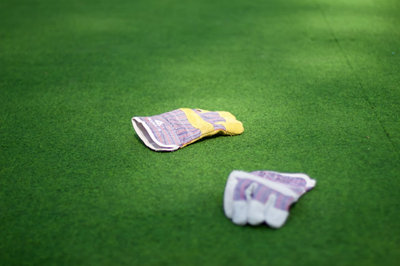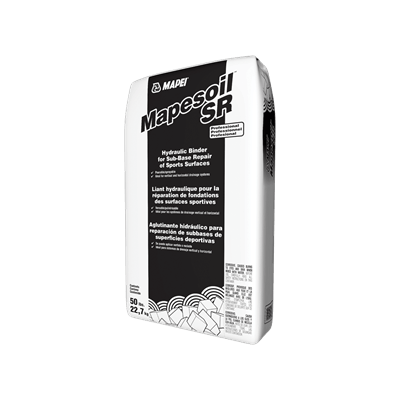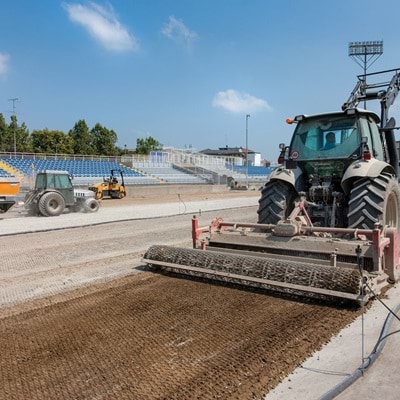
Sports are a huge part of many people's lives. Whether you're playing, coaching, or just spectating, the quality of the playing surface affects your game experience a lot more than you might realize.
For popular outdoor sports, such as soccer, football, baseball, rugby and ultimate (better known to some as "ultimate frisbee"), the construction and maintenance of synthetic playing surfaces has a major influence on the quality and safety of gameplay, as well as the enjoyment of the athletes.
Now, as more and more recreational and professional leagues are moving towards synthetic turf surfaces and away from natural grass, it's worth taking a look at the best practices for synthetic turf installation and maintenance.

Synthetic turf has become an increasingly popular choice for sports fields because of its versatility and durability. Synthetic turf fields offer a number of other benefits for both recreational and professional athletes as well.
Besides being much more durable than natural grass, synthetic turf fields are much easier to maintain than natural grass fields. There is no need to mow or water them, and they can be cleaned with a brush or broom in just a few minutes. Synthetic turf fields also provide a much safer playing surface than natural grass. They are less likely to cause injuries, and the infill material within the grass blades protects athletes from scrapes or cuts.
This makes them ideal for use in busy recreational centers, where there is little time for regular maintenance. So the question is: How do you properly install and maintain it to ensure peak performance?

Broadly speaking, synthetic turf surfaces are made largely from one of three primary materials: polyethylene, nylon and polypropylene.
Polyethylene turf offers the closest resemblance to natural grass. Softer than other artificial fibers, polyethylene turf won’t cause burns or irritation when a player goes to ground, but this softness comes with a hefty price tag. It is much more expensive than other synthetic turf types, which is why it is commonly seen only in professional sports facilities.
Nylon is highly durable by nature, able to withstand lots of wear and tear, high traffic and heat. But this robustness comes with a major drawback. Nylon fibers are stiffer and rougher than other synthetic turf materials, which is why they can cause irritation, and even serious injuries, if a player falls and slides along the playing surface.
This type of turf isn’t nearly as robust or comfortable as nylon or polyethylene, but it comes at a low price point. Unsuitable for high-impact sports, this type of turf is best suited to smaller areas without heavy traffic, such as a putting green.

When building a new field or performing renovations on existing fields, the following tips and tricks will help you get the best results:
If you are having trouble with an existing turf surface or want to create a new synthetic turf playing surface, these tips, along with the right MAPEI products, can help you do the job right!


Le sport occupe une place importante dans la vie de nombreuses personnes. Que vous teniez le rôle de joueur, d’entraîneur ou de spectateur, la qualité de la surface de jeu influe sur votre expérience de jeu, et ce, bien plus que vous le pensez.
Pour les sports extérieurs populaires, tels que le soccer, le football, le baseball, le rugby et le disque volant d’équipe (mieux connu sous le nom de « ultimate frisbee »), la construction et l’entretien des surfaces de jeu synthétiques ont une influence majeure sur la qualité et la sécurité du jeu, ainsi que sur le plaisir des sportifs.
Aujourd’hui, alors que de plus en plus de ligues récréatives ou professionnelles se tournent vers les surfaces en gazon synthétique et délaissent le gazon naturel, il est pertinent de se pencher sur les meilleures pratiques d’installation et d’entretien du gazon synthétique.

Le gazon synthétique est devenu un choix de plus en plus populaire pour les terrains de sports en raison de sa polyvalence et de sa durabilité. Les terrains en gazon synthétique offrent également un certain nombre d’avantages supplémentaires pour les athlètes récréatifs et professionnels.
En plus d’être beaucoup plus durables que le gazon naturel, les terrains en gazon synthétique sont beaucoup plus faciles à entretenir que les terrains en gazon naturel. Il n’est pas nécessaire de les tondre ni de les arroser, et ils peuvent être nettoyés à l’aide d’une brosse ou d’un balai en quelques minutes seulement. Les terrains en gazon synthétique offrent également une surface de jeu beaucoup plus sûre que le gazon naturel. Ils sont moins susceptibles de provoquer des blessures, et le matériau de remplissage à l’intérieur des brins d’herbe protège les sportifs des éraflures et des coupures.
Cela les rend idéaux pour une utilisation dans des centres récréatifs très fréquentés, où le temps manque pour effectuer un entretien régulier. La question est donc la suivante : comment les installer et les entretenir adéquatement afin d’assurer des performances optimales?

De manière générale, les surfaces en gazon synthétique sont fabriquées majoritairement à partir de l’un des trois principaux matériaux suivants : le polyéthylène, le nylon et le polypropylène.
Le gazon en polyéthylène offre la plus grande ressemblance avec le gazon naturel. Plus souple que les autres fibres artificielles, le gazon en polyéthylène ne provoque pas de brûlures ni d’irritations lorsqu’un joueur touche le sol, mais cette douceur a un prix élevé. Il est beaucoup plus cher que les autres types de gazon synthétique, c’est pourquoi on ne le voit généralement que dans les installations sportives professionnelles.
Le nylon est par nature très durable, capable de résister à l’usure, à une circulation intense et à la chaleur. Cependant, cette robustesse s’accompagne d’un inconvénient majeur. Les fibres de nylon sont plus rigides et plus rugueuses que les autres matériaux de gazon synthétique, c’est pourquoi elles peuvent provoquer des irritations, voire des blessures graves, si un joueur tombe et glisse sur la surface de jeu.
Ce type de gazon est loin d’être aussi robuste et confortable que le nylon ou le polyéthylène, mais son prix est bas. Ne convenant pas aux sports à fort impact, ce type de gazon est mieux adapté aux petites zones sans circulation intense, comme un vert (putting green).

Lors de la construction d’un nouveau terrain ou de la rénovation d’un terrain existant, les astuces et conseils suivants vous aideront à obtenir les meilleurs résultats :
Assurez-vous que le support du terrain de jeu est solide, stable et structurellement sain.
Utilisez un adhésif sans solvant de haute qualité pour les joints.
Si vous avez des problèmes avec une surface de gazon synthétique existante ou si vous voulez créer une nouvelle surface de jeu en gazon synthétique, ces conseils, ainsi que les produits MAPEI adéquats, peuvent vous aider à accomplir le travail correctement!









Toll-free within Canada:
Technical Services at 1-800-361-9309
Customer Service at 1-800-668-1212
Copyright © 2025 MAPEI Inc. All rights reserved.
2900, avenue Francis-Hughes, Laval (Québec) H7L 3J5
Comments
Load more comments